Fix: “Cannot Rip One or More Tracks From the CD” WMP
Several Windows users are reporting that they are prevented from ripping music with Windows Media Player by the “Windows Media Player cannot rip one or more tracks from the CD” error. Most affected users report that the issue occurs when they try to rip an Audio CD.

What causes the Windows Media Player cannot rip one or more tracks from the CD error?
We investigated this particular issue by looking at various user reports and the methods that they used to resolve the issue. Based on what we gathered, there are several common scenarios that will typically trigger this particular error message:
- Error correction is disabled – Windows Media Player is equipped to fix minor errors that cannot be fixed conventionally. However, this option is disabled by default, so you’ll need to enable it manually.
- Unavailable locations are listed as libraries – This is a well known WMP bug that has been manifesting since Windows Vista. It usually occurs if one of the specified music libraries is actually a broken rip location.
- CD is being ripped to a low quality – You might be seeing the error message because you’re trying to rip the CD to a low quality. If that’s the case, you most likely circumvent the issue by ensuring that you’re ripping to an improved audio quality.
If you’re struggling to resolve this particular issue, this article will provide you with a collection of verified troubleshooting steps. Below you have a list of methods that other users in a similar situation have deployed to either resolve or circumvent the issue.
For the best results, follow the methods below in the order that they are advertised until you stumble upon a fix that resolves the problem in your particular situation.
Method 1: Enable Error correction
Some affected users have managed to resolve the issue by accessing the settings menu of Windows Media Player and enabling error correction. This can be done by accessing the Tools menu and checking error correction for both ripping and playback.
Error correction enables Windows Media Player to play or rip CDs that contain errors. This can be useful if you’re encountering the issue due to a CD writing error.
Here’s a quick guide on how to enable error correction in Windows Media Player:
- Press Windows key + R to open up a Run dialog box. Then, type “wmplayer” and press Enter to open Windows Media Player (WMP).

Run dialog: wmplayer - Inside Windows Media player, right-click on a free space where the ribbon should be and select Tools > Options.

- In the Options screen, go to the Devices tab and select your CD/DVD writer (the one that you want to use to rip your music files. With the writer selected, click the Properties menu.

Go to the Devices tab, select your writer and click Properties - In the Properties screen of your DVD writer, enabled Digital for both Playback and Rip, then check the box associated with Use error connection. Finally, hit Apply to save the changes.
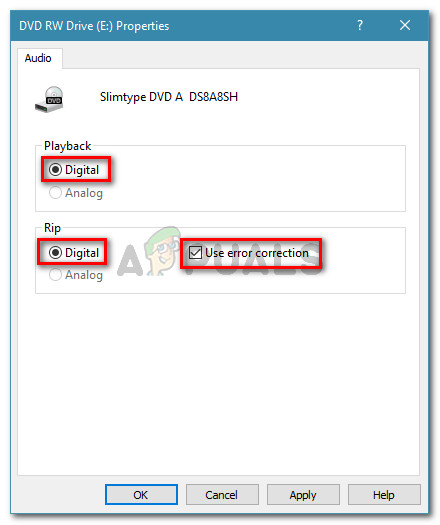
Set Playback and Rip to Digital, then enable Use error correction - Try to rip the music again and see if you still receive the same error message.
If you’re still seeing the “Windows Media Player cannot rip one or more tracks from the CD” error, move down to the next method below.
Method 2: Boost the quality of the ripped music
Other users encountering the same error message have managed to resolve the issue after using the Audio quality slider to set it to the highest (or second highest) quality available. Several affected users reported that once this setting was active, they where no longer encountering the “Windows Media Player cannot rip one or more tracks from the CD” error.
Here’s a quick guide on adjusting Rip settings quality in order to eliminate the error message:
- Press Windows key + R to open up a Run dialog box. Then, type “wmplayer” and press Enter to open up Windows Media Player.

Run dialog: wmplayer - Inside Windows Media Player, right-click on the ribbon and choose Tools > Options.

- In the Options window, go to the Rip Music tab and max the audio quality slider for each Format under Rip settings.

Set the slider for each Format under Rip settings to Best Quality (or second best) - Hit Apply to save the current configuration, then attempt to burn the music again to see if the process completes without the “Windows Media Player cannot rip one or more tracks from the CD” error.
If you’re still encountering the same issue, move down to the next method below.
Method 3: Removing unavailable locations
As some users have reported, the issue can also occur if you’re Windows Media Player is holding broken rip music locations. These can interfere with the ripping process and are known to trigger the “Windows Media Player cannot rip one or more tracks from the CD” error.
Several users in a similar situation have managed to resolve the issue after removing any unavailable locations and setting the correct music library as the default. Here’s a quick guide on how to do this:
- Press Windows key + R to open up a Run dialog box. Then, type “wmplayer” and press Enter to open up Windows Media Player.

Run dialog: wmplayer - Inside Windows Media Player, click on Organize > Manage Libraries, then click on Music.
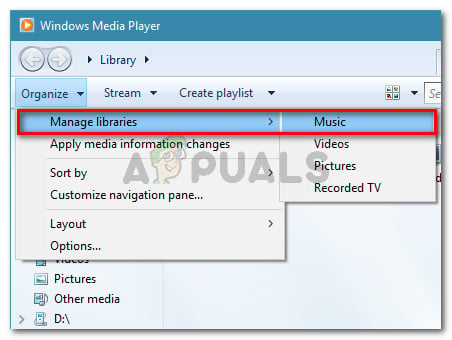
- In the Music Library Locations screen, remove any location that is no longer available by selecting it and clicking Remove. Once you removed every unavailable location, make sure that the files you’re trying to rip are located inside the Default folder.
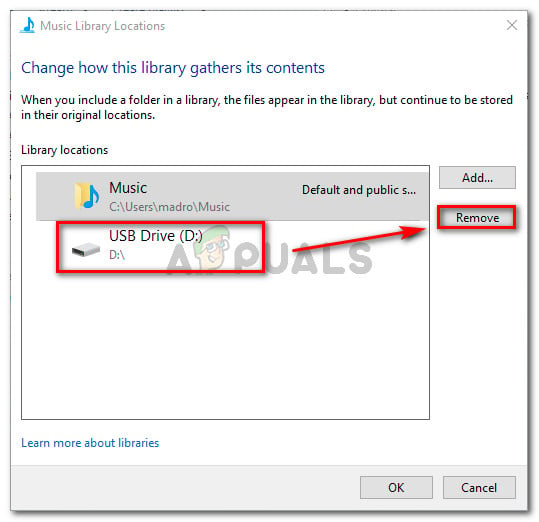
Removing any unavailable location from Music Library Locations - Restart Windows Media Player and see if the rip attempt is successful this time.
If you’re still encountering the “Windows Media Player cannot rip one or more tracks from the CD” error, move down to the next method below.
Method 4: Setting up the Music libraries folder
Several users struggling to resolve the same error have finally managed to get it resolved after noticing that they didn’t have a location to where the music is being ripped to. They fixed the issue by making sure that the main library folders (Music, Pictures, Videos and Recorder TV) all had specified locations.
Here’s a quick guide on how to do this:
- Press Windows key + R to open up a Run dialog box. Then, type “wmplayer” and press Enter to open Windows Media Player.

Run dialog: wmplayer - Inside Windows Media Player (WMP), right-click inside the ribbon bar and go to Tools > Options.

- Go to the Rip Music tab and see if you have any location listed under Rip music to this location. If you don’t have one, move down to the next steps below.

See if you have a location listed under Rip music to this location Note: If you already have a location listed, jump straight to Method 5.
- In WMP, click on the Organize tab, then choose Manage Libraries > Music.

- Under library locations, you should see a Music folder (typically located in C:\Users\*youruser*Music). If you don’t see it, click the Add button and then click on Include folder to add it manually.

Click Add, browse to the location of Music folder and click Include Folder - Repeat step 5 with every library folder left (Video, Pictures, Recorded TV).

Making sure the Library folder is set correctly for every type of media - Return to the Rip Music tab using step 5 and confirm that the Music library folder is set correctly. If it is, try to rip the music CD again and see if you’re still getting the same error message.
If you’re still seeing the “Windows Media Player cannot rip one or more tracks from the CD” error or this method wasn’t applicable, move down to the next method below.
Method 5: Restoring the Music library folder to Default
If you’ve come this far without a result, it’s very likely that WMP (Windows Media Player) is dealing with some corrupted files or settings that are inhibiting the ripping feature.
Several users have reported that they managed to resolve the “Windows Media Player cannot rip one or more tracks from the CD” error after restoring the Music library to the default and making sure that the save location is properly selected.
Here’s a quick guide on how to do this:
- Make sure that Windows Media Player is properly closed.
- Open File Explorer and expand the Libraries menu. Then, right-click on the Music library and choose Properties.
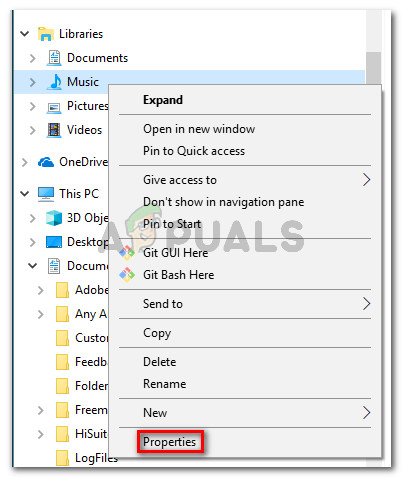
Right-click on the Music library and click on Properties - In the Music Properties window, click on Restore Defaults.
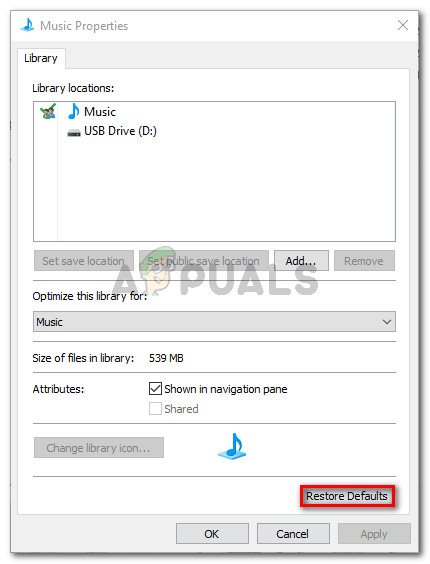
Click on Restore Defaults - Once the default settings have been reverted, restart your computer and see if you are able to burn the music without encountering the “windows media player cannot rip one or more tracks from the cd” error.





